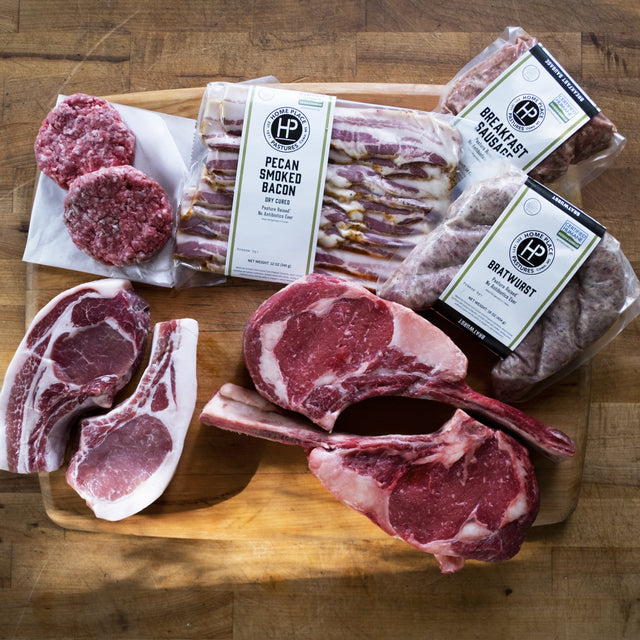First and foremost, I am not opposed to antibiotic use in animal or human health. Quite the opposite, I believe these miracle drugs are critical tools for both health systems. However, there’s a lesser known dirty little secret in industrial meat production involving these drugs that requires a lengthier description than can be encapsulated in a product label claim.
Industrial scale fattening of hogs, cattle, and chicken for harvest varies a bit from species to species, but the strategy is the same. To optimize efficiency and turn living beings into factory widgets, the animals must be crowded together. Proximity allows for efficient handling and feeding. While cattle are typically fattened in series of pens and lots outdoors, hogs and chickens are housed to further remove natural variables and augment automation.
While these industrialized food animal production systems work beautifully to churn out fattened livestock at unprecedented efficiency levels (labor per unit, feed per unit, space per unit, time per unit, total cost per unit, etc.), they are not without problems. Chief among these is disease. With cattle especially, the concentration involves aggregating thousands of head in finishing feed lots with origins on thousands of smaller farms around the country. Some of these cattle have been run through sale barns, where they have been exposed to every virus and bacteria known to the species. These animals have immune defenses from different exposures and vaccinations from their various regions and native farms, but mixed all together in tight quarters, fresh off a stressful long truck haul, everybody catches what everybody else is carrying (think daycare, but all the kids are also walking around in each other’s waste).
Disease is nature’s way of restraining these systems by enforcing a carrying capacity. When things get out of balance in an ecosystem, certain organisms therein become stressed, get sick and die until an equilibrium is reached. This natural law is not compatible with the needs of the industrial production system. So, how do CAFO’s (Concentrated Animal Feeding Operation) not experience unacceptable death loss and poor growth performance from all this disease exposure?
They hit every arrival with a slew of antibiotics, and thereafter preemptively mass medicate the inmates with daily, low doses of these drugs to prevent them from getting sick. This is called sub therapeutic treatment because the dosage is less than recommended treatment dosage. Using antibiotics to prevent sickness is key because treating an already sick animal might save its life, but it won’t save the money lost during a period of weight loss or decreased feed conversion. Sickness causes unacceptable inefficiencies. In a highly optimized system where every penny and man hour is tracked and weighed against the bottom line, it’s a simple decision. It’s more expensive to quarantine and selectively treat than it is to mass medicate, every day, to hold nature’s objections to this level of concentration at bay.
So, operators put the drugs in the water and feed and keep everything humming along. Yet even proponents of this model must acknowledge that it has two subtle but growing outcomes that are causing major concern (assuming animal and environmental welfare are not relevant metrics).
- Nature works quickly in these scenarios (daily, low dose exposure) to create resilient strains of bacteria that spread rapidly amongst the livestock and jump to humans via their overseers or via the food chain (more detail on this here: https://www.ncbi.nlm.nih.gov/books/NBK114485/)
- We use the same antibiotics in animal production systems that we do in human health care settings. We aren’t developing novel antibiotics because pharmaceutical companies have no incentive to spend the money to research and develop these drugs; it’s not profitable.
Decades of these outcomes combined with the overuse/ misuse of antibiotics in human healthcare have caused a global explosion of antibiotic resistant bacterial infections and diminishing efficacy of available antibiotics across the board. While health experts and policy makers are certainly tuned into this issue and working on solutions, the pipeline of new drugs is nowhere close to keeping up with rates of resistance. The Pew Foundation has comprehensive information on this topic. A good snapshot and some helpful data points can be found here: https://www.pewtrusts.org/en/research-and-analysis/data-visualizations/2023/antibiotic-resistant-bacteria-is-a-growing-threat-2023
Indeed, this is very serious stuff. It’s just one dirty little secret of industrialized meat production, but arguably the least understood. I find that in my conversations with customers comparing our practices with the industry's, customers are more focused on animal welfare concerns and growth promoting hormones associated with industrial production, rather than the antibiotic issue. And they are particularly unaware that this is not just an animal welfare issue or an issue of antibiotic residue in meats. In fact, it’s contributing to the rise of antibiotic resistant bacteria (superbugs): a global and dire human health concern.
I hope this sheds some light on why Home Place Pastures takes great pains to bear the claim “No Antibiotics Ever” on its products. It’s not because we don’t believe they should be used appropriately on humans or animals. It’s because we are committed to producing meat that does not rely on these drugs (ie industrial production). We must explain this commitment to consumers in a concise, black and white claim that fits on 3” x 4” label. We can’t say, “raised using antibiotics appropriately when animals are sick, not sub therapeutically in crowded conditions which contributes to antimicrobial resistance” on a label. That would certainly raise some eyebrows.
So we bear the claim, “No Antibiotics Ever”. But what do we do when we must give an animal medicine? We tag the medicated individual and keep records. We do not sell the animal under our brand (we sell them at the sale barn or to other farms, or most often directly to individuals who know they’ve been treated). We require our producers to do the same.
Fortunately for us and our livestock, we operate a totally different production system than the industrialized one detailed above. Our system is animal based, rather than efficiency based, and while it is certainly less efficient in terms of labor, space, time, and feed per unit produced, it also doesn’t require the inputs that the efficiency-based system does (drugs, chemicals, fossil fuels, water). Independence from these inputs makes us resilient. Our animals don’t get sick because they are outdoors with access to living forages and healthy soils. They are not mixed with thousands of other animals from all over the country, and they get to exhibit their natural behaviors. They are not stressed.
After farming this way for almost 10 years, I would argue that stress is as much a contributor to sickness in industrial production systems as communicable diseases (in fact they are closely related). When animals can’t get away from each other and do the things they evolved to do, it is maddening to them, and tragic to witness. The resulting stress weakens the immune system and welcomes infection.
This HUGE difference in our production system vs the industrial one gives me more pleasure than any other: it’s a joy to watch our livestock as they experience their day to day on the Home Place.
In conclusion, we use the label claim “No Antibiotics Ever” to assert our commitment to raising animals in a way that doesn’t require pre-emptive medicating or medicating at all really. In so doing, we help ensure that antibiotics will be around to keep us and our animals healthy for decades to come. We also get to enjoy watching our healthy animals improve our farm land, and share the wholesome bounty with you.
Always happy for a discussion on any topic I write about- email me at Marshall@homeplacepastures.com.
Thank you for reading!
Marshall
More stories

HPP: YOUR LOCAL REGENERATIVE MEAT LOCKER


